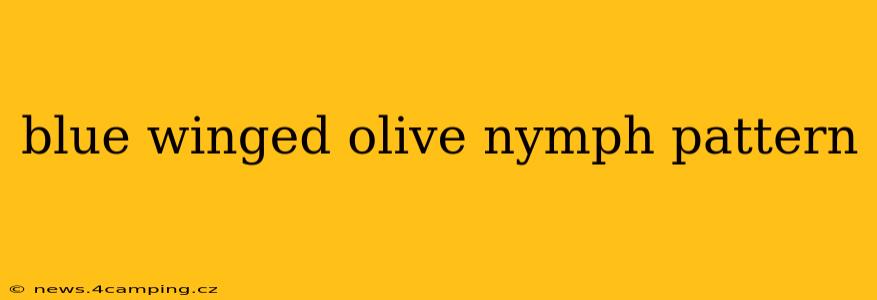The Blue Winged Olive (BWO) is a ubiquitous mayfly, a crucial part of the diet for many trout species. Mastering the art of imitating the BWO nymph is essential for any serious fly angler. This guide delves into the intricacies of crafting effective BWO nymph patterns, covering materials, techniques, and variations to help you consistently fool those discerning trout.
What Makes a Good Blue Winged Olive Nymph Pattern?
A successful BWO nymph pattern needs to accurately mimic the insect's natural form and movement. This involves paying attention to several key aspects:
-
Size: BWOs come in various sizes, typically ranging from size 18 to 24. Having a selection of patterns across this size range is critical, as trout will often key in on specific sizes depending on the hatch.
-
Shape: The nymph should possess a slender, segmented body that accurately reflects the olive’s natural shape. Avoid overly bulky patterns that might look unnatural underwater.
-
Color: The color should be a realistic representation of the BWO nymph's olive-brown to greyish-green hue. Variations in shading can mimic different life stages and water conditions.
-
Weight: A touch of weight is often necessary to get the nymph down to the trout’s feeding level, especially in faster currents. This can be achieved through the use of tungsten beads, wire ribbing, or other weighting materials.
What are the different types of BWO nymph patterns?
There are many variations of BWO nymph patterns, each with its own strengths and weaknesses. Some of the most popular include:
-
Standard BWO Nymph: This is a simple, yet highly effective pattern, often incorporating materials like pheasant tail fibers for the body, and a few strands of fine wire for ribbing. Its simplicity makes it easy to tie, and its effectiveness is undeniable.
-
BWO Emerger: Emergers are designed to imitate the nymph in its transition to the adult stage. They often feature a more upright profile with a slightly extended wing case.
-
Tungsten BWO Nymph: Incorporating a tungsten bead adds significant weight, allowing the fly to sink rapidly, ideal for deeper pools or faster currents.
-
BWO Soft Hackle: Soft hackle nymphs often use a soft hackle feather for the body, creating a lifelike, pulsating movement in the water.
How do I tie a basic BWO nymph pattern?
While numerous variations exist, the basic components usually remain consistent. A well-tied BWO nymph typically includes:
- Hook: A fine-wire nymph hook in size 18-24.
- Bead (optional): A tungsten bead for weight.
- Body: Pheasant tail fibers, dubbed dubbing, or other materials that create a slender, segmented body.
- Rib: Fine wire for ribbing, adding definition to the body.
- Thorax: A small amount of dubbing or other material to create the thorax.
- Legs (optional): Fine wire or other materials can be used to add legs for extra realism.
What materials are commonly used in tying BWO nymph patterns?
The best materials will depend on your desired effect, but common choices include:
- Pheasant tail fibers: These provide excellent natural segmentation and a subtle shimmer.
- Dubbing: A blend of fibers used to create the body, often in olive, brown, or green shades.
- Wire: Fine wire for ribbing and weighting.
- Fine hackle feathers: For creating a soft hackle nymph.
What are some variations of BWO nymph patterns?
Many experienced tiers modify the standard BWO pattern to suit different water conditions or to imitate different life stages. These variations might include different colors, weights, or materials, enhancing their effectiveness in specific situations.
Where can I learn more about tying BWO nymphs?
Numerous resources are available online and in print for learning to tie BWO nymph patterns. Many fly tying videos demonstrate step-by-step instructions, and instructional books can offer a more in-depth understanding.
This detailed guide provides a solid foundation for understanding and tying effective Blue Winged Olive nymph patterns. Remember, practice and experimentation are key to mastering this vital skill in fly fishing. Through refinement and adaptation to your specific fishing conditions, you can craft patterns that fool even the most selective trout.
